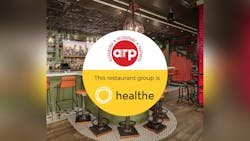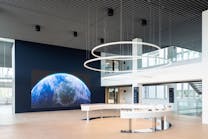Bankrupt Healthe names at least one 222-nm UV-C company among creditors
Healthe, Inc., the company that went bust after changing course from circadian lighting to disinfection lighting, has in its bankruptcy filings identified at least one other supplier of ultraviolet (UV) LED products to which it owes a disputed amount of money, in addition to Crystal IS.
In an assets-and-liabilities document on record with the United States Bankruptcy Court District of Delaware, Orlando-based Healthe states that it owes Champaign, IL-based Eden Park Illumination a “disputed” $18,900 for what Healthe calls a “trade payable.”
The filing does not describe the products related to the amount, but it is presumably for the 222-nm LED lamps that Eden Park provided to Healthe, which built them into its Healthe Space downlights for coronavirus disinfection purposes. Customers included Boll & Branch retail outlets; the Bluestone Lane cafe chain; Mia’s Italian Kitchen and Vola’s Dockside Grill restaurants in Alexandria, VA; and the 9600 condominium in Margate City, NJ.
On the other side of the coin, debtor Healthe also states that Eden Park owes Healthe in connection with Healthe’s patent violation suit against Somersworth, NH-based Far-UV Sterilray, a company which has countersued saying that Healthe is violating its patents. Sterilray is also known as High Energy Ozone (HEA).
Healthe’s original claim against Sterilray in the US District Court for the Middle District of Florida, Orlando Division makes no mention of Eden Park.
However, in its Chapter 7 bankruptcy filing, Healthe notes, “Debtor seeks to recover funds for litigations from Eden Park regarding Healthe Inc. v High Energy Ozone LLC d/b/a Far-UV Sterilray; S. Edward Neister; and Pathogen Path Consulting LLC, Case no. 6:20-cv- 02233.” It labels the amount as “unknown.”
The same filing also lists HEA (Sterilray) as a creditor to which Healthe owes an “unknown” amount “pending litigation.”
The 222-nm UV wavelength, also known as far UV-C, is often promoted as being safe when humans are exposed to it, as opposed to slightly longer-wavelength UV-C, which has to be shielded from occupants. Both have been proven to deactivate the SARS-CoV-2 virus that causes COVID-19, when used at certain dosages (radiometric energy over time intervals).
The $18,900 is small compared to other amounts in the assets-and-liabilities filing.
As LEDs Magazine reported last month, Healthe states in the bankruptcy document that it owes UV-C chip provider Crystal IS $2.7 million in a “disputed” claim.
Crystal is Healthe’s second-largest creditor after Healthe’s billionaire minority owner Stephen Ross, who owns the Miami Dolphins football team and is chairman of New York City-based international real estate giant Related Companies. Green Island, NY-based Crystal had provided the 265-nm LEDs that Healthe built into its Healthe Air ceiling troffers. Healthe installed the fixtures in the locker room and other facilities for the Miami Dolphins football team. The Dolphins tapped the fittings to help rid the air of the SARS-CoV-2 virus, which causes COVID-19.
Prior to bankruptcy, Healthe had potentially been in position to provide disinfection lighting across Related Companies properties.
Meanwhile, other LED chip providers also appear as creditors in Healthe’s Chapter 7 filing.
The papers state that Healthe owes Nichia Corp. an “unknown” amount related to “pending litigation.” The filing provides no details of the products involved. The two companies had countersued each other starting in 2019 regarding a dozen or so LED patents related to chip designs, packaging, and manufacturing processes. In October 2020, the US International Trade Commission issued a ruling in Nichia’s favor. It’s not clear whether the “pending litigation” in the recent bankruptcy papers are related to that case or to something else. Nichia’s portfolio of LED products includes 280-nm UV-C emitters.
Other creditors mentioned in the filing including Ushio America, owed a mere $7.44, and Houston-based Far UV Solutions, owed $903. The filing does not elaborate on the products.
The Healthe filing lists total liabilities of $15.1M and total assets of $12.2M. It quantifies the value of the company’s patents and intellectual property as “unknown” while enumerating 107 patents. The 107 are in various stages, including those being drafted, those issued, those expired, and those pending. They span a number of areas including disinfection and circadian. For most of Healthe’s two decades of life it specialized in circadian lighting, where it was a pioneer.
A separate bankruptcy filing related to the company’s equity and shareholding reveals that the company’s latest CEO is John Rajchert. In a curious episode last summer, Healthe hired a new CEO, Gerard Meyer, who lasted a couple of months at most. He left quietly, with Healthe providing no public announcement or ever offering an explanation or publicly announcing a replacement. Rajchert, based in Wayzata, MN, appears to have come from within the company.
MARK HALPER is a contributing editor for LEDs Magazine, and an energy, technology, and business journalist ([email protected]).
For up-to-the-minute LED and SSL updates, why not follow us on Twitter? You’ll find curated content and commentary, as well as information on industry events, webcasts, and surveys on our LinkedIn Company Page and our Facebook page.

Mark Halper | Contributing Editor, LEDs Magazine, and Business/Energy/Technology Journalist
Mark Halper is a freelance business, technology, and science journalist who covers everything from media moguls to subatomic particles. Halper has written from locations around the world for TIME Magazine, Fortune, Forbes, the New York Times, the Financial Times, the Guardian, CBS, Wired, and many others. A US citizen living in Britain, he cut his journalism teeth cutting and pasting copy for an English-language daily newspaper in Mexico City. Halper has a BA in history from Cornell University.





